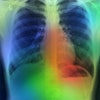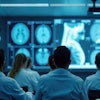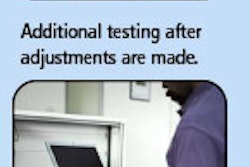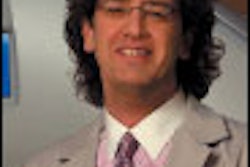With its roots now firmly planted in oncology, PET/CT has become a well-established diagnostic tool for cancer assessment, staging, and restaging. The combination of functional PET data with anatomical CT data has been shown time and again to provide more accurate and specific diagnoses than individual modalities alone, with the added bonus of sometimes detecting previously unknown tumors or conditions.
In fact, the advantages of PET/CT compared to PET alone are so great that PET/CT has taken over the PET market, especially in the U.S. Some 57% of currently installed systems are PET/CT units, versus 43% for PET cameras alone, according to a 2005/2006 census of installed equipment by market research firm IMV Medical Information Division of Des Plaines, IL.
"You can't buy a standalone PET anymore," said Dr. Peter Faulhaber, assistant professor of radiology at Case Western Reserve University in Cleveland. "For us -- an institution with a major cancer center that has used PET heavily -- we need to be on the cutting edge, and the image quality of PET/CT is better than standalone PET."
PET/CT's benefits are so great that it is beginning to expand from its beachhead in oncology and into cardiac imaging, neurology, and radiation therapy planning. Both academic institutions and private practices are employing the hybrid devices.
Oncology still accounts for the bulk of most caseloads -- on the order of 75% to 90% -- but PET/CT is also developing a following in cardiac and neuro imaging as the list of indications eligible for Medicare and Medicaid reimbursement grows. At the same time, though, the issue of reimbursement could cause PET/CT adoption to hit a snag, particularly in cardiac imaging (see sidebar at left).
"Having a PET/CT scanner, whether in hospital or outside, is really like setting up a small business." -- Dr. Harry Agress, Hackensack Medical Center, Hackensack, NJ
"PET/CT is now a major integral part of the oncology workup at our hospital," said Dr. Harry Agress of Hackensack Medical Center in New Jersey. "I think we are past the stage in many parts of the country where people have no idea what PET is. It is becoming so much the standard of care with a lot of cancers."Analyzing the economics
While the initial capital investment required to start a PET/CT service can be a challenge -- typically around $2 million to purchase and install a single system -- with the right economic and market evaluations it can make sense from a financial perspective.
A facility's return on investment is primarily dependent on the amount of competition in its catchment area, which clearly impacts the number of PET/CT studies that can be done in a day (typically around five to break even, although this is changing with the recent reimbursement cuts; the general consensus is that it now takes seven to eight studies a day to stay afloat). Other key factors include active participation with hospital tumor boards and educating referring doctors about the advantages of PET/CT and the indications for which it is most appropriate -- and reimbursable.
"Having a PET/CT scanner, whether in hospital or outside, is really like setting up a small business," Agress said. "It requires a new level of physician education of your referring docs for PET/CT versus just PET. Sometimes they want to order a CT scan with or without contrast, and you have to explain the differences to them; sometimes they don't want CT, so you have to explain that you need it for the attenuation."
There are alternatives for those sites still testing the PET/CT waters, such as adding PET to an existing CT scanner (which is how Agress' group first started) or setting up a mobile clinic to test a market's potential. Integral PET, a company based in New York City, owns and operates about 20 PET/CT facilities across the U.S., according to Ron Lissak, president of Integral PET. Because the cost of setting up a PET/CT center can range from $1.5 million to $3 million (depending on the equipment), they often move into a new region with a mobile service first.
"This business is very much about educating the referring doctors to see how PET/CT fits in their area," Lissak said. "After a couple of years, we then will build up to a fixed site, which is less risky and gives the radiologists time to build the referral pattern."
Hybrid diagnostics
Even if you're still weighing the pros and cons of investing in PET/CT, it's clear that the benefits in terms of patient care and throughput in many ways outweigh the potential economic concerns. In fact, because of its ability to combine functional and anatomic information and thus more clearly delineate what is going on when a potential tumor is detected and what the morphology is, it has become the standard of care in oncology diagnostics, according to Dr. Joe Busch of Diagnostic Radiology Consultants in Chattanooga, TN, which owns two PET/CT scanners.
Other advantages include reductions in the time a cancer patient must be on the scanner table (15 minutes for a typical diagnostic PET/CT today, versus one hour for standalone PET on an older system), which increases both throughput and patient comfort, with the added bonus of incidental findings.

"Cancer patients -- in staging, restaging, and in response to therapy -- already get CT scans as well as PET, so why not do them on the same machine, at the same time?"
-- Dr. Joe Busch, Diagnostic Radiology Consultants, Chattanooga, TN
Busch believes that IV and oral contrast is necessary to differentiate pathological FDG from normal physiological FDG activity, for example lymph nodes from blood vessels and loops of bowel. In addition, high-resolution imaging (336 matrix) with IV contrast is essential in head/neck, abdomen, and pelvic cancers to detect subcentimeter metastasis.
Busch, who is a major proponent of producing diagnostic-quality images with every scan versus using CT just for attenuation correction, described a recent case in which they were staging a cervical carcinoma by using PET/CT to stage the lymph nodes. IV and oral Volumen contrast were used, and interpreting the anatomical structures from the CT scan under the functional images from the PET scan, he was able to determine that the cancer was not as advanced as first thought.
"It turned out the patient's right ovary was located against the iliac artery and vein and two loops of the small bowel," he said. "By giving her the IV contrast and oral Volumen, I was able to show the arteries, veins and the ovaries and localize the small bowel activity. I determined that the activity in the ovary was physiological. Hybrid imaging enables us to more accurately localize and distinguish between pathological and physiological structures."
In another case, an incidental finding of an 8-mm breast lesion was detected during the staging of a patient's lung cancer.
Beyond oncology
At Case Western, oncology also represents the majority of the cases Faulhaber and his colleagues see, primarily for diagnosis and staging of cancers but also for radiation therapy planning. In his practice, the leading indications are lung cancer, lymphoma, and head and neck cancer, followed by colon and cervical cancer.
"One of the limitations of PET/CT is that it is purely driven by what is reimbursable," he said. "Most of us are doing diagnostic CT, followed by PET, because we want to keep the dose as low as possible. The focus of the best way to treat the patient is evolving, but the emphasis is still on using the lowest dose possible." He said new radiopharmaceuticals are being developed that more specifically target tumors versus just sugars, such as amino acids, peptides, and precursors to amino acids. However, while many of these agents are now available, only FDG (in oncology) is approved for reimbursement.
In addition to oncology, about 10% of the cases Faulhaber and his colleagues review are neurology and cardiac imaging -- a ratio that is echoed by most PET/CT centers in the U.S. The leading indication in neurology is brain scans for epilepsy and evaluating dementia. Radiologists in the PET/CT program at Michigan State University in East Lansing, MI, for example, work closely with referring physicians to help diagnose what type of dementia is affecting their patients, according to Dr. Kevin Berger, director of the PET/CT program.
"We happen to serve a referral population with a lot of neurologists and gerontologists interested in differential diagnoses of dementia such as Alzheimer's versus fronto-temporal dementia, which is the most common clinical indication for using PET in neurology," Berger said. Among other things, his department is helping validate diagnosis of PET brain analysis by comparing a patient's brain metabolism to that of a control group, and quantifying the findings.
"This can be difficult to assess statistically if looking at a single patient," he said. "But this approach gives us a quantitative way to communicate to a referring doc that a certain area of the brain is this far away from asymptomatic controls."
Berger's department is also using PET/CT for cardiac imaging -- specifically, evaluating myocardium viability and myocardial perfusion. He cites many advantages to using PET/CT rather than SPECT for these applications, including improved patient throughput (rest/stress studies can be done in less than an hour, versus up to six hours in some cases with SPECT), greater accuracy, lower radiation exposure (especially in patients with chronic cardiac disease who must undergo stress studies for years), and attenuation correction. In addition, because too many diagnostic catheterizations are still being done unnecessarily, there is a push to improve the accuracy of perfusion studies, which is where cardiac PET comes in.
"There is a general perception that cardiac PET/CT is better for overweight patients or large-breasted women, but it is really a better technology across the board compared to conventional SPECT imaging in all patients," said Dr. Kenneth Henson, director of cardiovascular imaging at Imaging for Life in Sarasota, FL. "There is higher accuracy, and you can combine it with attenuation correction to get better outcomes."
With the advent of 64-slice CT, the role of PET/CT in cardiology should expand even further. Dr. Frank Bengel, director of cardiovascular nuclear medicine at Johns Hopkins Medical Institutions in Baltimore, recently upgraded his hybrid unit to a 64-slice CT and says it is "very attractive" for combined morphological imaging of the heart.
"Since I worked with 16-slice previously, I can tell you how much the 64-slice is an advantage for cardiac imaging," he said. "Sooner or later, it will be the standard in cardiac imaging, not just for coronary angiography but for perfusion as well."
But Henson doesn't think combining PET with 64-slice CT makes sense from a patient management perspective because he sees the two technologies as sequential, not simultaneous. At Imaging for Life, he uses a 64-slice dedicated CT for coronary angiography and an eight-slice PET/CT for everything else, with the CT only for attenuation correction.
"You use CT to diagnose coronary artery disease and cardiac PET to determine the functional significance of the disease," he said. "But most patients undergoing coronary angiography do not need PET."
In the long run this debate may become moot. The recent cuts in reimbursement for cardiac imaging studies could eventually impact adoption of the technology, according to Henson and others.
"I think the future of this technology will be determined by Medicare, and to some extent the third-party carriers," Henson said. "If they could take a long-term view of this, they would see it is a more accurate technology than the older SPECT studies and that you can substantially reduce the number of cardiac cath procedures."
By Kathy Kincade
AuntMinnie.com contributing writer
March 1, 2007
Copyright © 2007 AuntMinnie.com



















